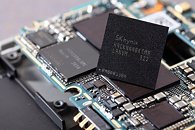- Joined
- Oct 9, 2007
- Messages
- 47,794 (7.40/day)
- Location
- Dublin, Ireland
| System Name | RBMK-1000 |
|---|---|
| Processor | AMD Ryzen 7 5700G |
| Motherboard | Gigabyte B550 AORUS Elite V2 |
| Cooling | DeepCool Gammax L240 V2 |
| Memory | 2x 16GB DDR4-3200 |
| Video Card(s) | Galax RTX 4070 Ti EX |
| Storage | Samsung 990 1TB |
| Display(s) | BenQ 1440p 60 Hz 27-inch |
| Case | Corsair Carbide 100R |
| Audio Device(s) | ASUS SupremeFX S1220A |
| Power Supply | Cooler Master MWE Gold 650W |
| Mouse | ASUS ROG Strix Impact |
| Keyboard | Gamdias Hermes E2 |
| Software | Windows 11 Pro |
SK Hynix Inc. announced that it has developed the world's first 8 Gb(Gigabit) LPDDR3 (Low Power DDR3) using its advanced 20nm class process technology. This product is a top-performance mobile memory solution which features high density, ultrahigh speed and low power consumption.
The new products can be stacked up and realize a high density of maximum 4 GB(Gigabytes, 32 Gb) solution in a single package. In addition, the height of this package becomes dramatically thinner than the existing 4 Gb-based one. In terms of its high density and competitive package height, it is suitable for the newest trend of the mobile applications.

The product works at 2133 Mbps which surpasses 1600Mbps of existing LPDDR3 in the aspect of its data transmission speed and is the world's fastest mobile DRAM. With a 32-bit I/O it processes up to 8.5GB of data per second in a single channel, and 17GB in a dual channel. It works at ultra low-voltage of 1.2V.
While this new LPDDR3 runs two times faster than LPDDR2, its standby power consumption decreases more than 10% compared to LPDDR2 products, therefore it satisfies both low power consumption and high performance which mobile applications highly demand.
It can be provided in various forms such as 'PoP'(Package on Package) or being in a single package with 'eMMC'(embedded Multi Media Card) which is installed in mobile gadgets as well as 'On-board' type embedded in high-end ultrabooks and tablets.
"With the development of this high density LPDDR3 using 20nm class, SK Hynix is now able to supply a top-performance product suitable for mobile devices to the market", Senior Vice President Richard Chin, the Head of Global Sales & Marketing said. "Especially, this development has its significance since the Company has secured top-level competitiveness in mobile products by developing it simultaneously with PC DRAM using the same 20nm class process technology" he added.
Samples of this new product have been shipped to customers and the Company plans to start mass production of it at the end of this year.
High density LPDDR3 memory products over 2GB are expected to be noticeably loaded mainly on to high-end mobile devices from the second half of this year. To meet the growing needs of mobile market, SK Hynix plans to develop the most advanced technologies for the rapidly evolving mobile applications industry and will lead the market with the high performance products.
View at TechPowerUp Main Site
The new products can be stacked up and realize a high density of maximum 4 GB(Gigabytes, 32 Gb) solution in a single package. In addition, the height of this package becomes dramatically thinner than the existing 4 Gb-based one. In terms of its high density and competitive package height, it is suitable for the newest trend of the mobile applications.

The product works at 2133 Mbps which surpasses 1600Mbps of existing LPDDR3 in the aspect of its data transmission speed and is the world's fastest mobile DRAM. With a 32-bit I/O it processes up to 8.5GB of data per second in a single channel, and 17GB in a dual channel. It works at ultra low-voltage of 1.2V.
While this new LPDDR3 runs two times faster than LPDDR2, its standby power consumption decreases more than 10% compared to LPDDR2 products, therefore it satisfies both low power consumption and high performance which mobile applications highly demand.
It can be provided in various forms such as 'PoP'(Package on Package) or being in a single package with 'eMMC'(embedded Multi Media Card) which is installed in mobile gadgets as well as 'On-board' type embedded in high-end ultrabooks and tablets.
"With the development of this high density LPDDR3 using 20nm class, SK Hynix is now able to supply a top-performance product suitable for mobile devices to the market", Senior Vice President Richard Chin, the Head of Global Sales & Marketing said. "Especially, this development has its significance since the Company has secured top-level competitiveness in mobile products by developing it simultaneously with PC DRAM using the same 20nm class process technology" he added.
Samples of this new product have been shipped to customers and the Company plans to start mass production of it at the end of this year.
High density LPDDR3 memory products over 2GB are expected to be noticeably loaded mainly on to high-end mobile devices from the second half of this year. To meet the growing needs of mobile market, SK Hynix plans to develop the most advanced technologies for the rapidly evolving mobile applications industry and will lead the market with the high performance products.
View at TechPowerUp Main Site




